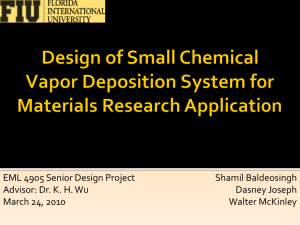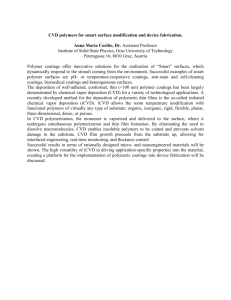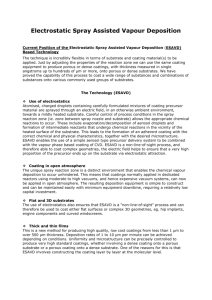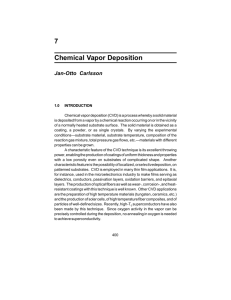Thermal Chemical Vapor Deposition
advertisement
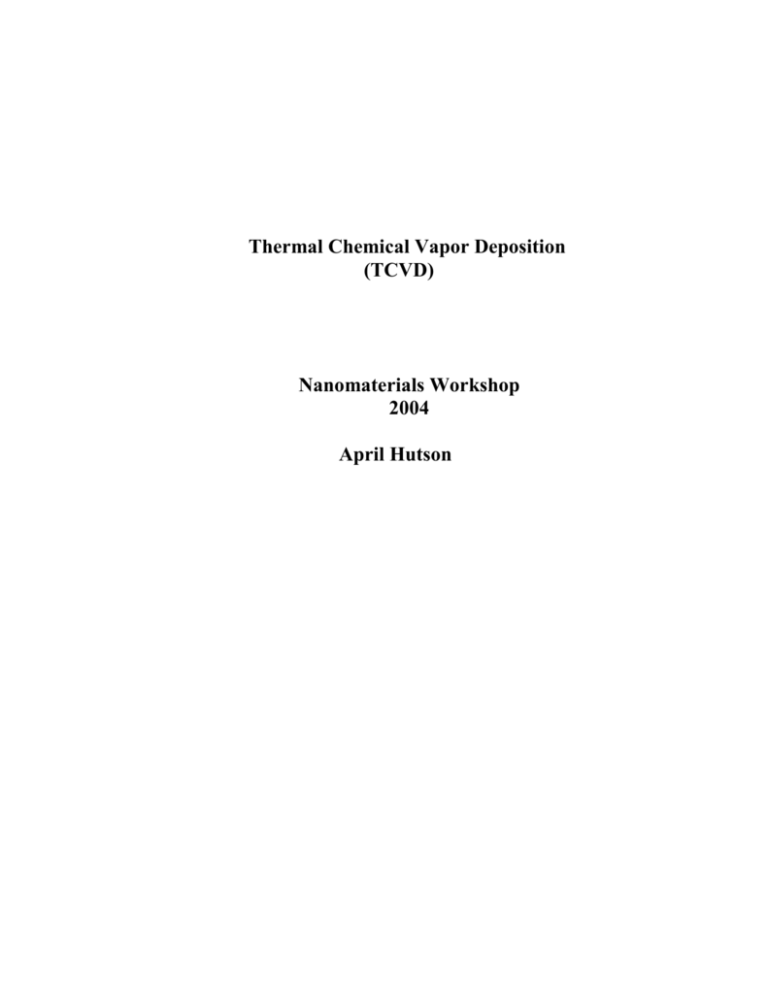
Thermal Chemical Vapor Deposition (TCVD) Nanomaterials Workshop 2004 April Hutson Thermal Chemical Vapor Deposition (Thermal CVD) Chemical Vapor Deposition (CVD) is defined as a chemical process for depositing thin films of various materials. In a typical CVD process the substrate is exposed to one or more volatile precursors, which react and/or decompose on the substrate surface to produce the desired deposit. Volatile by products are also produced and are removed by gas flow through the reaction chamber. In Rapid Thermal CVD (RTCVD) the process uses heating lamps or other methods to rapidly heat the substrate. Heating only the substrate rather than the gas or chamber walls helps reduce unwanted gas phase reactions that can lead to particle formation. For example in this process decomposition of the gasses AX and BY into A and B as well as X and Y will not occur anywhere but on a hot substrate surface in an idealized thermal CVD. No deposition of film AB occurs on cool walls and fixtures as is the case in of plasma assisted CVD. In Thermal CVD the growing film see only thermal surface energy delivered either by the substrate heater or by the condensing atoms, which form the film. This thermal surface energy gives atoms sufficient mobility on the surface so that uniform thickness film growth and good surface coverage occurs. The higher the deposition temperature, the better the film coverage on the substrate. The substrate temperature alone aids both the surface chemistry and surface atom mobility. Parameter of interest is the ratio of the substrate temperature to the melting point of the deposited film. It is important to monitor the temperature as you would not want to melt the substrate. The selective nature of thermal CVD is to deposit films only on surfaces above a critical temperature. This can be taken a step further by using catalytic surfaces that will decompose reactants at a lower temperature than non-catalytic surfaces. Advantages of Thermal CVD: 1. variety in products and hydrocarbon sources 2. adequacy for synthesis of high quality material 3. controllability of microscopic structures (ex: carbon nanotubes 4. simplicity of apparatus Disadvantages of Thermal CVD: 1. flow of the reaction gas leads to unstable gas supply 2. sensitivity to temperature change and position in chamber Steps in Thermal CVD synthesis of carbon nanotubes: 1. Fe, Ni, Co, or alloy of the tree catalytic metals is initially deposited on a substrate. 2. Etch the substrate in diluted HF solution with distilled water. 3. Place specimen in a quartz boat. 4. Position boat in a CVD reaction furnace. 5. Nano-size fine catalytic metal particles are formed after an additional etching of the catalytic metal film using NH3 gas at a temperature of 750 to 1050C. (forming these fine catalytic metal particles is the most important process as these become the nucleation sites for carbon nanotubes which are directing related to the size of the metal particles) 6. Carbon nanotubes are grown on these fine catalytic metal particles. Safety : Due to the nature of the gasses this must be setup in the fume hood. Hydrogen (H2) and Methane (CH4) are flammable gasses Ammonia (NH3) hazardous: inhalation & bodily contact, pungent irritating odor Observe all lab safety protocol Always wear goggles Wear gloves Below is a schematic diagram of a thermal CVD apparatus in the synthesis of carbon nanotubes. Reaction gas is supplied on one end of the apparatus, and gas outlet in the other end. Thermal Chemical Vapor Deposition Sources 1. 2. 3. 4. 5. 6. 7. 8. 9. www.iljinnanotech.co.kr/en/material/r-4-4.htm www.endo.sandia.gov/DAKOTA/applications/cvd.html www.encyclopedia.thefedictionary.com/Chemical%20vapor%20deposition www.tlchm.bris.ac.uk/pt/diamond/end.htm www.fluent.com/solutions/examples/x64.htm Jakob, Surface Sci. 275, 407 (1992) Selective Epitaxy: IEEE Trans. on Elec. Dev., Nov. 1983, p. 1510. Endeavour Magazine 19(3), (1995) pp101-106.
